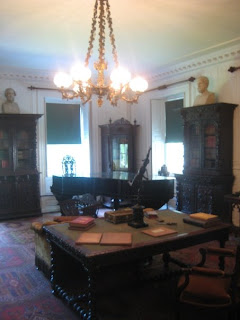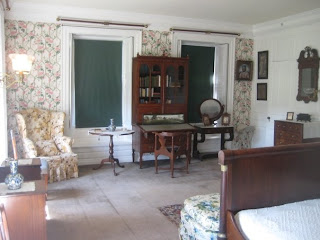For almost fifty years the Georgian mansion was the home of noted American poet Henry Wadsworth Longfellow. For a time, it had previously served as the headquarters of George Washington in the 18th century.
The house was built in 1759 for John Vassall, who fled the Cambridge area at the beginning of the American Revolutionary War because of his loyalty to the king of England. George Washington used the abandoned home as his first official headquarters as commander of the Continental Army; the home served as his base of operations during the Siege of Boston until he moved out in July 1776. Andrew Craigie, Washington's Apothecary General, was the next person to own the home for a significant period of time. After purchasing the house in 1791, he instigated the home's only major addition. Craigie's financial situation at the time of his death in 1819 forced his widow Elizabeth Craigie to take in boarders. It was as a boarder that Henry
Wadsworth Longfellow came into the home. He became its owner in 1843, when his father-in-law Nathan Appleton purchased it as a wedding gift. He lived in the home until his death in 1882. Among the illustrious visitors to cross the threshold were Charles Dickens, invited for breakfast during his first tour of America, and playwright Oscar Wilde, who said of his host, “Longfellow was himself a beautiful poem.” When strangers knocked, asking to see “Washington’s headquarters,” Longfellow graciously showed them around.
The last family to live in the home was the Longfellow family, who established the Longfellow Trust in 1913 for its preservation. The home was donated in 1972, along with all its furnishings, and was made part of the National Park Service. The home, which represents the mid-Georgian architectural style, is seasonally open to the public.
Longfellow died in 1882 and his daughter Alice Longfellow was the last of his children to live in the home. In 1913, the surviving Longfellow children established the Longfellow House Trust to preserve the home as well as its view to the Charles River. Their intention was to preserve the home as a memorial to Longfellow and Washington and to showcase the property as a "prime example of Georgian architecture".
In 1962, the trust successfully lobbied for the house to become a national historic landmark.
In 1972, the Trust donated the property to the National Park Service and it became the Longfellow National Historic Site; it is now open to the public as a house museum. On display are many of the original nineteenth century furnishings, artwork, over 10,000 books owned by Longfellow, and the dining table around which many important visitors gathered. Everything on display was owned by the Longfellow family.
The site also possesses some 750,000 original documents relevant to the former occupants of the home. These archives are open to scholarly research by appointment. Today we are touring
Henry W. Longfellow's study,
In the original Vassall House — as well as during George Washington’s stay — this room was the dining room. When Henry and Fanny first occupied the house after their marriage in 1843 this room was their combined dining room and parlor. In 1845, after completing their dining room and library, the Longfellows converted the space to their study.
From the mid-1840s until Henry W. Longfellow’s death in 1882, the room served as his study, a well-used place where he read, wrote poetry, correspondence, and journal entries, reviewed proofs, visited with family and friends, smoked cigars, played with his children, and took naps. During Fanny’s lifetime, although clearly Henry’s room, it was to a great degree her study and a family gathering room as well. Henry W. Longfellow's study,
The Library The bookcases hold many of Henry Longfellow's foreign-language books: the nineteenth-century French poets in elaborate gold-tooled bindings, the Italian poets in white vellum, and the German poets in green leather.
The Library. On a bracket above the mantel is a Louis XIV pendule (shelf clock) made in Paris in 1745 in a Boule-work case with ormolu mounts of masks, leaf scrolls, and cornucopias, and the figure of a seated child above. In 2002, the clock was cleaned and restored. Bronzes on the library's mantel (Left) Setter France, c. 1840s-60s
by Pierre-Jules Mene bronze sand-cast, probably by the artist (Right) Rachel France, 1839 by Jean-Pierre Dantan bronze sand-cast, Guesnel foundry It is not known how this room was used during the early history of the House, but during George Washington's occupation of the mansion, it served as the staff room for his aides. Following the American Revolution, Andrew Craigie enlarged this room towards the north as part of his overall expansion of the building.
As the largest room in the house, it was frequently used for gatherings of family and friends. Many birthday dances and other parties, magic lantern shows, piano performances, funerals and weddings were held here. The Longfellows enjoyed the library for its views of the garden. At Christmas time the room was festively draped with holly and greens.
In the center of the room is a bronze chandelier with six chain festoons and six branches in grape-vine design.
This was originally a gasolier from the Henry N. Hooper Co. of Boston, made around 1850 and installed in 1853.
Henry Wadsworth Longfellow by Thomas Brock1885 marble bust
The Library
This painting of Henry Longfellow by Cephus Giovanni Thompson 1840 was not especially popular with the family when it was painted. Samuel Longfellow observed that it was not at all like him.
Alexander W. Longfellow Sr. told Henry, "It has a sneaking, downcast, and sinister expression, which belongs to anybody sooner than yourself. You look, on that canvas, as if you had been stealing sheep, which I am confident you never did. The portrait looks, making his pardon, much more like Dickens than you." An engraving of this portrait by Cheney was used as an illustration in Cary and Hart's American Poets.
Alice's bedroom is located in the front of the House with views to the south and west.
Originally, the only access to the room was from the center hallway, but sometime after 1840 two doors were cut into the north wall providing access to the shared bathroom and the closet. It is not known how and by whom this room was used the first 70 years or so of the House's occupancy. Elizabeth Craigie used it as her bedroom after Andrew Craigie's death in 1819. During Henry and Fanny Longfellow's lifetime (1843-1882) this room served as a guest room.
By 1855 when Fanny bore the Longfellow's last child, Anne Allegra, this was the birthing room. Probably about 1892, after the death of Samuel Longfellow, Alice Mary Longfellow made this room her bedroom. After her death in 1928 this room served as a guest room for family and boarders.
When George Washington took over the House for his headquarters in the summer of 1775, this front room became one of his two private chambers. Some sixty years later, Henry W. Longfellow, then a professor at Harvard, rented this room and the one behind it from Elizabeth Craigie. For the next six years this room served as his study and dining room.
A year after Henry and Fanny Longfellow married in 1843, this room became the nursery for the first born child, Charley Longfellow and the other children. From Fanny Longfellow's death in 1861 until 1868, this room served as a classroom for the Longfellow children and some of their friends. The Longfellows traveled to Europe in 1868 for a year and a half, and upon their return they transformed this room into Edith and Annie Longfellow's bedroom. After Edith and Annie had married and moved out, Alice Longellow began using the room as her study in the 1890s.
This room probably served as a bedroom for Jackie and Nelly Custis, Martha Washington's son and daughter-in-law, during their stay from December 11, 1775 through April 1776. There is little information about this room's use until the nineteenth century.
For nearly a century this room seems to have been the master bedroom in the Vassall-Craigie-Longfellow House. This room served as Andrew and Elizabeth Craigie's bedroom and later as Henry and Fanny Longfellow's bedroom until Henry's death in 1882. Samuel Longfellow, the younger brother of Henry Longfellow, moved into the House shortly after his brother's death. This room served as his bedroom until his death in 1892. Visiting family and boarders used this room as their bedroom from the 1890s until 1972.
This room is nearly unchanged from 1759. The outstanding feature of the room is a set of English and Dutch fireplace tiles depicting biblical scenes, animals, ships, and ruins.
The fireplace was reduced in size at an early date.
Henry Longfellow described many of the tiles in his poem, To a Child, written for his son Ernest.
"Thou gazest at the painted tiles,
Whose figures grace,
With many a grotesque form and face.
The ancient chimney of thy nursery!
The lady with the gay macaw,
The dancing girl, the grave bashaw
With bearded lip and chin;
And, leaning idly o'er his gate,
Beneath the imperial fan of state,
The Chinese mandarin."
The Blue Room along with the front room on the east side (Alice's Study) of the second floor served as George Washington's private chambers during his nine-month stay (July 1775-April 1776) in the Vassall House.
This room served as Henry Longfellow's bedroom when he boarded here in Mrs. Craigie's house (1837-1841) and continued to be Henry Longfellow and Fanny Appleton Longfellow's bedroom until 1844. The room then served as the nursery for the young Longfellow children. From the 1850s through the late 1890s, this was Alice Longfellow's bedroom. She then moved her bedroom to the front room. After her death in 1928 it served as the guest room for visiting family members and friends until 1972.
Painting of Henry Longfellow at age thirty four by Joseph Alexander Ames.
Henry W. Longfellow was a supporter of the movement to abolish slavery in the United States, both before and during the Civil War. In addition to authoring his Poems on Slavery, Longfellow corresponded and was acquainted with many prominent abolitionists. Click here or on the link in the menu on your left to view an online exhibit discussing Henry W. Longfellow's role in the abolition movement.
Basement
Longfellow family items in the basement
























































No comments:
Post a Comment